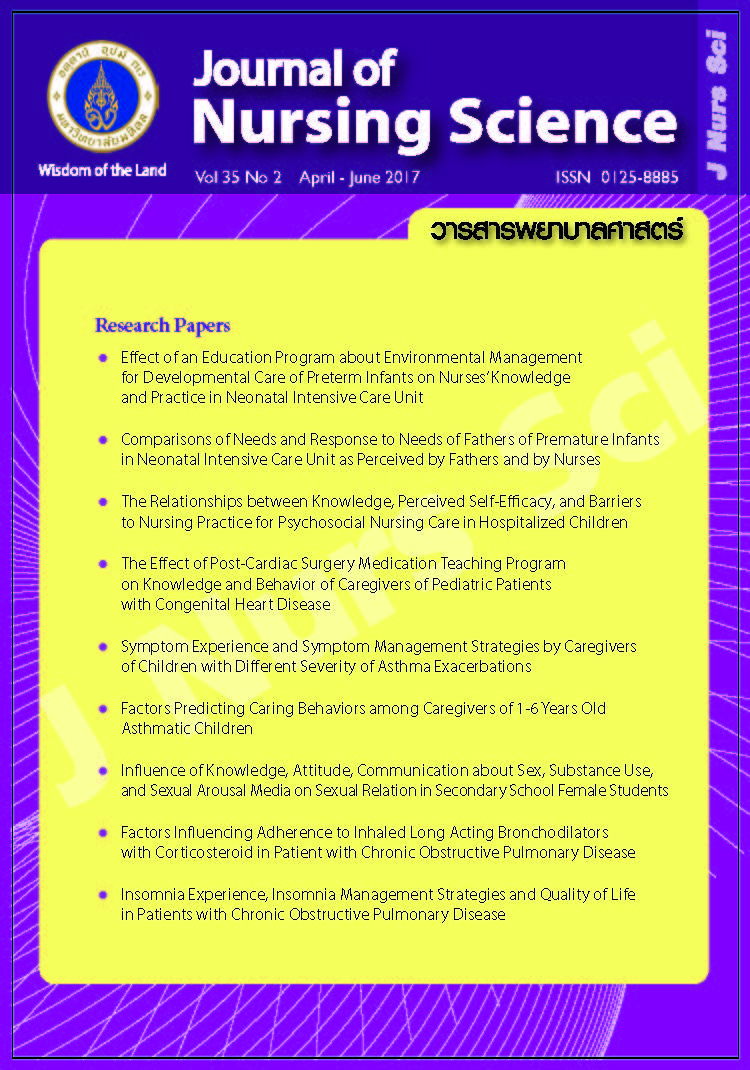Factors Predicting Caring Behaviors among Caregivers of 1-6 Years Old Asthmatic Children
Main Article Content
Abstract
Abstract
Purpose: This study aimed to examine the factors predicting caring behaviors among caregivers in families of 1-6 years old asthmatic children.
Design: Correlational predictive design.
Methods: The sample was composed of 94 caregivers who brought asthmatic children for treatment in the asthma clinics. The research instruments included questionnaires on the personal information of the caregivers and the asthmatic children, knowledge about asthma, perceived self-efficacy in caring behaviors, perceived social support, and the family caregivers’ caring behaviors. Data was analyzed with descriptive statistics and multiple regression analysis.
Main findings: The findings showed that 50% of caregivers were mothers with a mean age of 39.7 years (SD = 11.9). The sample had a high mean score of overall caring behaviors in asthmatic children (Mean = 3.09, SD = .345). The mean of behaviors in using asthma medication to control symptom were the highest (Mean = 3.67, SD = .53). The asthmatic children had a mean age of 4
years. The mean duration of treatment was 2 and half years. The results of the multiple regressionanalysis revealed that all of the independent variables were accounted for 25% of variance in caring behaviors among caregivers of asthmatic children (R2 = .250, df = 3, 93 F = 10.006) with statistical significance (p < .05). Perceived self-efficacy and perceived social support were powerful predictors of family caregivers’ caring behaviors in asthmatic children with statistical significance (β = .363, p < .05 and β = .247, p < .05).
Conclusion and recommendations: Based on the research findings, nurses and health care teams should promote caregivers’ competencies in perceiving self-efficacy in asthma care. In addition, family members should recognize the importance of providing care in asthmatic children to ensure that caregivers are able to express caring behaviors for asthmatic children.
ปัจจัยทำนายพฤติกรรมการดูแลของผู้ดูแลเด็กโรคหืดอายุ 1-6 ปี*
บทคัดย่อ
วัตถุประสงค์: เพื่อศึกษาปัจจัยทำนายพฤติกรรมการดูแลของผู้ดูแล เด็กโรคหืดอายุ 1-6 ปี
รูปแบบการวิจัย: การศึกษาหาความสัมพันธ์เชิงทำนาย
วิธีดำเนินการวิจัย: กลุ่มตัวอย่าง คือ ผู้ดูแลเด็กโรคหืด จำนวน 94 คน ที่พาผู้ป่วยเด็กโรคหืดอายุ 1-6 ปี เข้ารับการรักษาที่คลินิกโรคหืดของโรงพยาบาลชุมชน จำนวน 3 แห่ง เก็บข้อมูลโดยใช้แบบสอบถาม ข้อมูลส่วนบุคคลของผู้ดูแล และผู้ป่วยเด็กโรคหืด ความรู้เกี่ยวกับโรคหืด การรับรู้สมรรถนะในการดูแลเด๊กโรคหืด การรับู้แรงสนับสนุนทางสังคมและพฤติกรรมการดูแลเด็กโรคหืดของผู้วิเคราะห์ และวิเคราะห์ข้อมูลด้วยสถิติเชิงพรรณนา และสถิติการวิเคราะห์การถดถอยแบบพหุคูณ
ผลการวิจัย: กลุ่มตัวอย่างเป็นมารดามีอายุเฉลี่ย 39.7 ปี (SD = 11.9) มีพฤติกรรมการดูแลผู้ป่วยเด็กโรคหืดโดยรวมอยู่ในระดับมาก (Mean = 3.09, SD = .345) ค่าเฉลี่ยพฤติกรรมการดูแลเมื่อมีอาการหืดกำเริบด้วยยาอยู่ในระดับมากที่สุด (Mean = 3.67, SD = .53). ผู้ป่วยเด็กอายุเฉลี่ย 4 ปี เข้ารับการรักษาในคลินิกโรคหืดนาน 2 ปี 6 เดือน ผลการศึกษาพบว่า ตัวแปรอิสระท้งั หมดสามารถอธิบายความแปรผันของพฤติกรรมการดูแลในผ้ปู ่วยเด็กโรคหืดได้ ร้อยละ 25 (R2 = .250, df = 3, 93 F = 10.006) อย่างมีนัยสำคัญทางสถิติ (p < .05) โดยพบว่า การรับรู้สมรรถนะในการดูแลเด็กโรคหืดและการรับรู้แรงสนับสนุนทางสังคม มีอำนาจการทำนายพฤติกรรมการดูแลเด็กโรคหืดของผู้ดูแล
อย่างมีนัยสำคัญทางสถิติ (β = .363, p < .05 และ β = .247, p < .05 ตามลำดับ)
สรุป และข้อเสนอแนะ: พยาบาลและทีมสุขภาพควรส่งเสริมให้ผู้ดูแลมีความมั่นใจและรับรู้สมรรถนะของตนเองในการดูแลเด็กโรคหืดมากขึ้น ส่งเสริมให้สมาชิกในครอบครัวเห็นความสำคัญของการดูแลผู้ป่วยเด็กโรคหืดร่วมกับผู้ดูแลหลัก เพื่อให้ผู้ดูแลสามารถแสดงออกถึงพฤติกรรมการดูแลได้ดีขึ้น
คำสำคัญ: ผู้ดูแลเด็กโรคหืด พฤติกรรมการดูแล ความรู้โรคหืด การรับรู้สมรรถนะ แรงสนับสนุนทางสังคม
Article Details
Copyright Notice: Nursing Science Journal of Thailand has exclusive rights to publish and distribute the manuscript and all contents therein. Without the journal’s permission, the dissemination of the manuscript in another journal or online, and the reproduction of the manuscript for non-educational purpose are prohibited.

Disclaimer: The opinion expressed and figures provided in this journal, NSJT, are the sole responsibility of the authors. The editorial board bears no responsibility in this regard.


